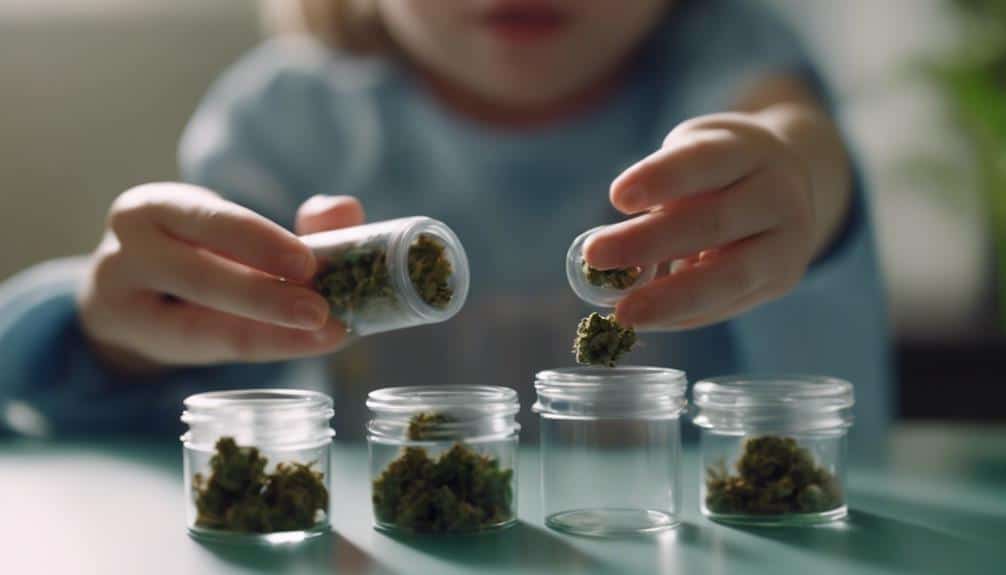Navigating the world of medical marijuana for children is akin to walking a tightrope, balancing between ethics, evidence, and safety.
You’re caught in a crossfire of controversial debates, grappling with questions about the efficacy of cannabis treatments, the ethical implications of its use in minors, and how to ensure safety in such a poorly regulated field.
This situation is a minefield that requires a delicate balance of information and intuition. Could there be an undiscovered potential in this stigmatized plant for our young patients?
Stay tuned; the answer might surprise you.
Ethical Dilemmas in Pediatric Cannabis Use

When navigating the ethical intricacies of pediatric cannabis use, you’ll encounter numerous complex issues. These range from potential health risks and benefits to legal and societal implications. At the heart of this ethical maze lies Parental Consent. It’s not just about parents’ rights to decide for their child but also their ability to make informed decisions.
Consider whether parents fully understand the potential risks and benefits of this unconventional treatment. The lack of comprehensive research into long-term effects exacerbates this issue, creating a significant Physician Dilemma. Physicians find themselves stuck between their obligation to do no harm and their duty to alleviate suffering.
The ethical implications extend beyond individual families to societal perceptions as well. The stigma associated with cannabis use might influence parents’ decisions or lead them towards secretive use, bypassing medical guidance altogether. The lack of legal clarity across different jurisdictions further complicates matters, leaving physicians and parents navigating a murky ethical landscape.
Thus, the ethical dilemmas in pediatric cannabis use are a tangled web of interconnected aspects, each requiring careful thought and analysis.
Evaluating Current Research
So, what does current research say about pediatric cannabis use?
The jury is still out, but the evidence so far leans towards cautious optimism. However, research limitations persist with most studies being observational or anecdotal. This lack of randomized controlled trials is primarily due to legal and ethical challenges associated with cannabis research.
Key findings include:
- Some studies suggest cannabis may alleviate symptoms in children with treatment-resistant epilepsy.
- Research indicates potential benefits for pediatric patients with autism or cancer-related symptoms.
- However, optimal pediatric dosages aren’t well established, posing potential risks.
- The long-term effects on cognitive development and mental health aren’t fully understood yet.
- Most studies have small sample sizes which limit their validity.
The current body of evidence is promising but far from conclusive. You must tread cautiously in this nascent field, balancing potential benefits against potential risks. The knowledge gaps underscore the importance of further research to establish safe and effective pediatric dosages and understand the long-term effects fully.
Safety Measures for Child Patients

When considering medical marijuana for children, prioritizing stringent safety measures to mitigate potential risks is crucial. Dosage control is paramount. You must carefully measure the amount of marijuana administered to minimize chances of adverse reactions. This isn’t as simple as providing less to smaller patients, as children’s bodies can react differently to drugs than adults’. Consulting a medical professional well-versed in pediatric dosages of medical marijuana is essential.
Administration methods also play a vital role in safety. Sublingual drops allow for precise dosage control and are easy for children to take. Edibles can be harder to measure accurately and may pose a risk of accidental overconsumption. Vaporized or smoked marijuana should be avoided entirely due to potential lung damage.
The goal is therapeutic benefits without causing harm. Therefore, constant monitoring and adjustment of dosage are necessary, along with regular check-ups tracking any changes in the child’s condition. It’s a careful balancing act, but with the right precautions, medical marijuana can safely be administered to children.
Potential Therapeutic Benefits
While ensuring safety is paramount, it’s also important to recognize the potential therapeutic benefits that medical marijuana can offer children suffering from certain conditions. The effectiveness of cannabinoids in alleviating symptoms and enhancing quality of life makes a strong case for its use.
Consider these potential benefits:
- Reduction in epileptic seizures: Studies have shown that cannabinoids can reduce the frequency and severity of seizures in conditions like Dravet syndrome.
- Alleviation of chronic pain: Medical marijuana can provide pain relief for conditions unresponsive to conventional treatments.
- Appetite stimulation: For children suffering from conditions like cancer or AIDS, cannabinoids can boost appetite and combat weight loss.
- Relief from chemotherapy-induced nausea: Medical marijuana can help manage the unpleasant side effects of chemotherapy.
- Improvement in Autism symptoms: Preliminary studies suggest cannabinoids may reduce behavioral troubles in children with Autism.
The key challenge lies in dosage determination. It’s vital to administer the right dosage to ensure safety and efficacy. Excessive doses can lead to adverse effects, while inadequate doses might not produce the desired relief. In this context, further research and regulatory guidelines are necessary for clarity.
Regulatory Aspects and Legalities

Navigating the regulatory landscape surrounding medical marijuana use in children can be complex due to varying laws across states and countries. You’ll encounter policy challenges as there are no uniform policies regarding therapeutic cannabis use in pediatric populations. Legal conflicts arise due to disparities between state and federal laws, with some states permitting its use while it remains federally illegal.
A deep understanding of these regulatory aspects is essential for effectively advocating for your patients. Familiarize yourself with legal intricacies, including necessary protections for you and your patients, while considering ethical implications of treating children with medical marijuana.
Besides, staying up-to-date with the latest research and clinical trials will help you make evidence-based decisions—a crucial aspect of navigating this complex issue. Informed decisions protect your patients but also contribute to broader societal dialogue surrounding medical marijuana. Remember that your primary goal is to serve others, which includes advocating for safe and effective treatments within legal boundaries.
Conclusion
Navigating the world of medical marijuana for children can often feel like walking a tightrope. You wrestle with ethical dilemmas, sift through emerging research, consider safety measures, weigh potential benefits against legal hurdles. It’s not an easy path but with careful steps, it’s a journey worth exploring. At the end of it, you may find a treatment that brings relief to your child—a ray of hope in an often shadowed world.
We invite you to visit us at Fells Point Cannabis Docs of Maryland to learn more about this complex yet promising field. We’re here to guide you through the intricacies and answer any questions you may have. We understand that this is a challenging journey and we’re here to support you every step of the way. So why not give us a call or come by for a visit? We look forward to meeting you and exploring the possibilities together.

